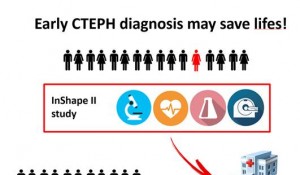
Transition from acute to chronic thrombosis
One of the most feared complications of venous thromboembolism (VTE) are permanent hemodynamic changes due to unresolved thrombi or vascular damage caused by thrombosis. Half of patients treated for deep vein thrombosis (DVT) or pulmonary embolism (PE) suffer from post-thrombotic syndrome and post-PE syndrome, respectively. The most severe presentation of the post-PE syndrome is chronic thromboembolic pulmonary hypertension (CTEPH), a fatal disease unless diagnosed in time and treated by surgical removal of the chronic clots from the pulmonary artery tree. The process that prevents acute blood clots from resolving causing CTEPH is unknown, and currently, awareness for this complication is too low as demonstrated by a diagnostic delay of over 1 year.
Current studies of our department focus on evaluation of easy, non-invasive screening algorithms for CTEPH after acute PE based on radiological parameters of the CT used to diagnose PE, clinical parameters and the combination of ECG reading and measurement of NT-proBNP level. Also, we are investigating whether pulmonary rehabilitation may be an effective treatment of less severe presentations of the post-PE syndrome.
Three relevant publications of our group (with collaborators) within this theme are:
1. Ende-Verhaar YM, Cannegieter SC, Vonk Noordegraaf A, Delcroix M, Pruszczyk P, Mairuhu AT, Huisman MV, Klok FA. Incidence of chronic thromboembolic pulmonary hypertension after acute pulmonary embolism: a contemporary view of the published literature. Eur Respir J. 2017;49(2)
2. Bochenek ML, Rosinus NS, Lankeit M, Hobohm L, Bremmer F, Schütz E, Klok FA, Horke S, Wiedenroth CB, Münzel T, Lang IM, Mayer E, Konstantinides S, Schäfer K. From thrombosis to fibrosis in chronic thromboembolic pulmonary hypertension. Thromb Haemost 2017;117:769-783
3. Klok FA, Zondag W, van Kralingen KW, van Dijk AP, Tamsma JT, Heyning FH, Vliegen HW, Huisman MV. Patient outcomes after acute pulmonary embolism. A pooled survival analysis of different adverse events. Am J Respir Crit Care Med 2010;181:501-506


